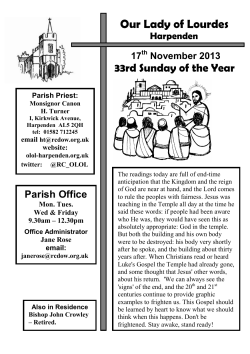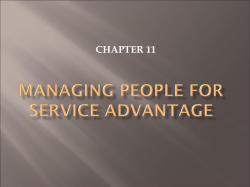
This chart accompanies the first in designed specifically for frontline
This chart accompanies the first in a series of online research briefings designed specifically for frontline practitioners who work with children and families. This chart was created from a number of sources including: To get the most value from the chart, we would encourage you to look at the accompanying online research briefing on our website. The online material covers key aspects of child development, bringing together a concise summary of research and theory with pointers for action. It also has links to other useful resources, which will inform your practice and give you more confidence in your professional judgement. > Ellis L, Lass I and Solomon R (1998) Keeping children in mind. A model of child observation. London: CCETSW Child development chart: 0-11 years > Piaget J (2001) 3rd ed. The Language and Thought of the Child. London: Routledge This chart is an aid and easy-to-reference reminder of typical stages of development. You will want to consider each child’s circumstances, abilities and needs in using this to assess whether there may be grounds for concern or further investigation. Keep in mind that the sequence of attaining development milestones is important as well as age. www.rip.org.uk/frontline > Aldgate J, Jones D, Rose W and Jeffery C (eds) (2006) The Developing World of the Child. London: Jessica Kingsley > Erikson EH (1995) Childhood and Society. London: Vintage > Fahlberg V (1994) A Child’s Journey through Placement. London: BAAF > Sheridan MD (1997) 2nd ed. From Birth to Five Years Children’s developmental Progress. London: Routledge Online text and chart written by Helen Donnellan child development chart: 0-11 years Physical, emotional, cognitive and psychosocial development working together with www.rip.org.uk/frontline theory / stage 0-6 months 1 year 2 years 3 years 4 years 5 years 6 years 7 years 8 years 9-11 years developmental theory: Lifts leg; grasps foot. Lifts head. Rolls over front to back. Eyes move in unison. Turns to carer’s voice. Vocalises, laughs. Puts everything to mouth. Sits and crawls. May stand alone. Picks up small objects. Uses both hands. Knows and turns to own name. Babbles. Drinks from cup. Stranger anxiety likes to be within sight and hearing of familiar adult/ caregiver. Runs and climbs on furniture. Can walk backwards. Walks down stairs. Builds tower of six bricks. Uses 50 words. Uses own name – not ‘I’. Dry during day. Demands attention. Cannot share. Walks up stairs. Turns while running and pulling toys. Walks on tip toe. Draws person with head. Cuts with scissors. Knows full name and uses ‘I’. Asks what, where and who questions. Uses fork and spoon. Dry at night. Can share. Turns sharp corners, running, pushing and pulling. Hops and climbs. Draws person with head, trunk, legs and often arms. Speech intelligible – 1500 words. Gives name and address. Appreciates past, present and future. Helps with dressing. Skips, dances and hops. Copies square and triangle. Writes a few letters. Draws a house. Counts fingers on one hand. Gives name, age, address and birthday. Dresses/ undresses alone. Very active physically. Developing concentration. Wants to take on more than can manage. Often regresses to an earlier stage under pressure. Responds to praise. Co-operative but needs help. Concentration much improved and gets very absorbed. More likely to sulk and be withdrawn when in difficulties. Easily frustrated by own failures. Learning about ‘fairness’ and ‘luck’. Eager but impatient with self and others. Better at group games and at losing. Has more developed sense of time. Interested in own past. Developing sense of humour and interest in jokes and riddles. Quick and extreme emotional shifts. Increasingly independent and cooperative but can be critical. Integrates learning from multiple sources. Outside home and peer friendships important. Worried by mistakes and school failure. sensorymotor stage Although language development and thought begins, the major developmental tasks in this stage relate to experiencing the world through the five senses (sensory): learns to crawl and walk (gross motor) and to grasp and manipulate small objects and simple ‘tools’ (fine motor). Learns how to learn through exploration and manipulation of surroundings, linking cause and effect: for instance, understands that shaking a rattle produces noise or that sucking produces milk. Understands that objects are permanent and exist even when not visible. Beginnings of self-identity. preoperational stage Capable of symbolic representations of the world in play and language. Uses toys to represent something else. Not yet capable of sustained systematic thought. Develops language and drawing to express self and experiences. Becoming less egocentric. concrete operational stage Able to think logically to solve problems and organise information learned. Able to: > u nderstand that some things remain unchanged despite changes in appearance: eg, liquid in different shaped cups > mentally reverse a process or action > concentrate on more than one aspect of a situation at a time > deduce new relationships from earlier ones: eg, if pencil A is longer than B and B is longer than C, then A must be longer than C > order things in sequence > group objects on the basis of common features Begins to think logically about concrete events but difficulty understanding abstract concepts or general principles applied to specific events. Sequential stages, defined by physical, cognitive and emotional milestones theorists: Sheridan M, 1997 Fahlberg V, 1994 cognitive theory: Ways of thinking about interactions with the surrounding world theorist: Piaget J, 1896-1990 psychosocial theory: Specific developmental stages or social ‘crises’ which need to be resolved in a pre-determined sequence although uncompleted stages can be resolved at any time theorist: Erikson E, 1902-1994 trust vs mistrust autonomy vs shame and doubt initiative vs guilt industry vs inferiority First feelings form about the world and whether or not it is a safe place, based on the level of familiarity, consistency and continuity of carers and care-giving. Positive experiences lead to a belief that people are reliable and loving. Trust, security and hope or the strong belief that the world is a good place develop. Unreliable or inadequate care leads to fear and inner mistrust of the world. May be apprehensive, insecure and mistrustful. Increasing self-awareness and desire to do things themselves. Will power develops; defiance, tantrums and stubbornness may appear. Needs safe space for experimenting without shame or ridicule as new skills are tried out (eg, food choices, toy preferences, clothing selection). Displays pride in assertion of choice and autonomy. Failure to manage transitions lead to feelings of worthlessness and inadequacy, doubting own ability to act autonomously. Low self-esteem and a tendency to be overly dependent on others can develop. Conscience and imagination develops. Understanding of what people expect of them and with some responsibility for own actions. Begins to assert power and control over the world through directing play of all sorts, including fantasy. Learns to cooperate with others and to lead as well as to follow. Initiative grows when encouraged to make plans and express fantasies safely, developing new skills and abilities to learn, enjoy, and achieve mastery. Has sense of purpose and feels capable. Attempts to exert too much power lead to experiences of disapproval, and feelings of guilt develop. Can become fearful, hang on the fringes of groups, continue to depend unduly on adults. Displays limited play skills and imagination. Initiative is squashed where carers interfere with, interrupt or control free play, create too many strict boundaries or force too much responsibility. Wants to learn, stick to tasks, do things well and learn from others. Possibly competitive. Consciously putting problem-solving and language skills to work. Through social interactions, begins to develop pride in accomplishments and abilities. Encouraged and commended by parents, teachers and peers, a sense of competence and belief in skills develops. Prior mastery of trust, autonomy and initiative provides the basis for increasing self-discipline, application and industry . Repeated failure and criticism leads to frustration and inadequacy. The mistrusting child will doubt the future; the shame-and-guilt filled child will experience defeat and inferiority which can be exacerbated by racism and sexism. www.rip.org.uk/frontline This chart should help you to understand the development stage of children you are working with and whether there are grounds for concern and further investigation. It shows the stages of typical development. You will of course need to consider it alongside the specific circumstances of each child, and will want to consider abilities as well as needs. It is important to note that the sequence of attaining development milestones is important as well as the age.
© Copyright 2025





















